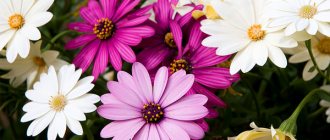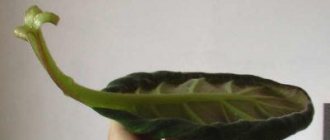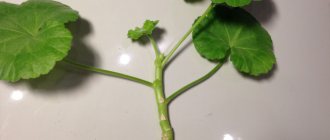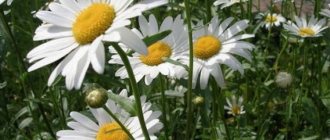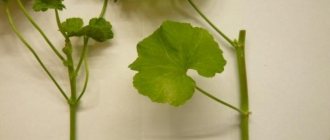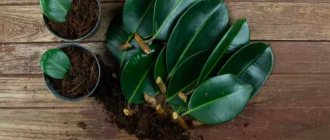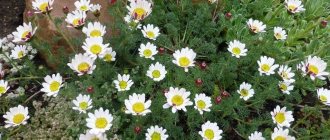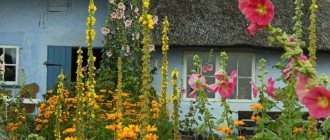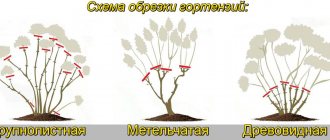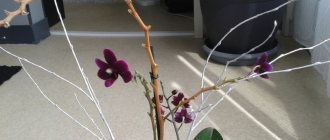Yellow daisies are pretty, compact flowers that are often used to create unique colorful arrangements in the garden. Moreover, in botany they are called doronicum. There are quite a few varieties of these plants. Each of them has certain characteristics.
Yellow daisies are beautiful flowers that are used in landscaping.
Doronicum perennial - what kind of garden flower is it, what family does it belong to?
Doronicum (Doronicum) is a perennial flower belonging to the Asteraceae family. The plant also has other names - gooseberry and yellow chamomile.
Brief description, history of origin, why prairie flower
The plant has wrapper leaves characteristic of chamomile, growing in several rows around corymbose inflorescences. There is a small bulge at the top of the peduncle. The oval, oblong serrated leaves have a dense structure and can reach 12 cm in length. The diameter of the corymbose inflorescences is about 5 cm. The reed flowers have a bright yellow color.
Yellow daisies
The first mention of yellow daisy dates back to 1584. The species is believed to have originated in the Mediterranean. The flower grows in dry places that have almost turned into steppes and meadows.
Interesting! The plant is also found on rocky slopes, sunny edges, forest clearings and bushes.
Yellow garden chamomile: plant characteristics
Chamomile gets its name from the Latin word Matricaria, which means “uterine herb.” This is a genus of flowering perennial plants from the Asteraceae family. The flower blooms already in the first year of life.
This genus includes more than twenty different species of herbs. The most common is chamomile or fragrant. In our country it is bred for medicinal purposes. Fresh and dried chamomile herb is used as an anti-inflammatory, antiseptic mouth rinse, for preparing medicinal infusions, and for treating the gastrointestinal tract. This plant is widely used in cosmetology: it is part of creams, shampoos, and balms. Used in aromatherapy (the tops and flowers of the plant contain essential oils) as a sedative.
Yellow garden daisy
Interesting: we must remember that chamomile can cause allergic reactions, which means there may be contraindications for it.
Wild chamomile can be found in America, Africa, Europe and Asia.
The name chamomile came to us from the Poles in the 16th century, translated as “Romanov’s color.” Historical documents contain references to chamomile in the second half of the first century. Pliny the Elder (Roman scientist) wrote about chamomile in his encyclopedia, calling it Chamaemellon, which is translated from Greek as “low apple.” It received this name for its low size and light aroma, reminiscent of an apple.
Note! Chamomile begins to bloom in April and blooms until late autumn. Pollinated by bees and wasps.
The plant is not tall, the length of the stem can be from 15 to 60 cm. The greenery of the flower is pinnate. The inflorescence consists of two components: the core is made of small tubular flowers, and along the edge there are white false-ligulate petals. The root system is weakly branched.
Description of varieties bred from pure Doronicum
What are the names of flowers that look like daisies?
Based on this variety, many beautiful varieties have been bred.
Doronicum eastern
Herbaceous perennial plant, half a meter tall. Places of growth - the Caucasus, the Mediterranean and Asia Minor. The ovate basal foliage with long petioles is serrated along the edges. The diameter of the pale yellow flowers is 3-5 cm. The core has a brighter, golden hue.
Doronicum eastern
Doronicum plantain
The height of the plant reaches one and a half meters. On strong, slightly branched shoots there is oval, dark green foliage. The foliage is serrated.
Doronicum plantain
Cluse
Habitat: high alpine meadows. The height of the plant is up to 30 cm. The jagged foliage is covered with cilia and thick pile. At the pubescent top there is a bright yellow basket. The diameter of the flowers is 3-6 cm.
Doronicum Clews
Growing from seeds
Doronicum is grown both through seedlings and through direct sowing of seeds in open soil.
Seedlings
Perennial gladioli flowers - description
Seeds are sown in April. Until the end of spring - beginning of summer, seedlings should be kept indoors. Once the threat of frost has been minimized, they can be planted in open ground.
Using the seedless method
Doronicum flower loves semi-shaded places, away from trees. The soil should be light and slightly acidic. Before sowing, the area should be dug up and complex fertilizer should be added to the soil. In the spring, before sowing, the furrows are filled with water.
Important! In autumn, soil moisture is not required, since crops may freeze or get wet.
Basic growing rules
Ampelous unpretentious perennial flowers for the garden
Now you need to understand how doronicum is grown from seeds and when the flower needs to be planted on the site.
Preparing and sowing seeds
Cellular trays can be used as planting containers. An earth mixture is poured into them - coarse sand and peat (in a ratio of 1 to 1). Up to 3 seeds are sown in each cell, the containers are covered with film, and placed in a place inaccessible to sunlight.
Deadlines
Sowing seeds should be done in mid-spring - in April. The seedlings should spend a month to a month and a half at home. In early June they can already be planted on the site.
How to care for seedlings
Seedlings need systematic ventilation, removal of condensation and moistening of the soil mixture. When the first shoots appear, the level of illumination needs to be increased. Weak tall plants (more than 4 cm) need to be pruned. One of the most persistent sprouts should be left in each compartment.
Seedling care
14 days before planting, you need to start hardening the seedlings daily.
Note! The most effective way to grow yellow chamomile is the seedling method.
Site selection and soil preparation
Semi-shaded areas with loose, moderately moist soil are ideal for the flower. It is not recommended to plant chamomile close to the trunks of mature trees. The soil should be dug deeply (a quarter of a meter deep) in the autumn. During planting, feed the soil with rotted manure.
Planting in open ground
The planting holes should be at a distance of half a meter from each other. The size of the hole should correspond to the size of the seedling with a ball of earth. The flower is placed in the hole, sprinkled, compacted in the soil, and then slightly moistened.
Reproduction
Growing your own yellow daisy flower is easier than many other types of garden plants. In order to plant doronicum, you can resort to the following methods:
- Propagation by seeds. In summer, the drying boxes are cut off and dried on the windowsill. The seeds are removed from the head and further dried on a sheet of paper.
- Dividing the bush by cuttings. The simplest and most effective method, since yellow chamomile is a perennial plant, and next year the planted bush will bloom and delight the gardener.
- Planting with sections of the root system. The roots of Doronicum are strong and long, so it can be propagated by simply moving part of the soil to another place on the site.
Features of plant care in open ground
The Doronicum flower, planting and caring for which does not require special attention, still has its own growing characteristics.
Watering
Since chamomile roots are located at the top layer of soil, the plant needs frequent moderate watering. Water the flower with settled warm water.
Spraying
During hot periods, the plant requires evening spraying or sprinkling procedures. It is important not to overdo it, otherwise you can provoke diseases.
Caring for chamomile outdoors
Humidity
It is difficult for yellow daisies to tolerate excess moisture, so it is better not to plant flowers near large trees or in low-lying places.
Priming
Acidic, clayey and heavy soil is not suitable for chamomile. The best option would be light, loose, slightly acidic soil containing useful substances.
Feeding
In spring, the plant needs complex fertilizers. Both mineral compounds and organic matter are suitable for the flower. At the end of August, during the period of growing new rosettes, the roe grass is fertilized with nitrogen-containing compounds.
Note! Yellow perennial chamomile is resistant to cold, so it does not need to be covered in winter.
Pink and white flowers similar to chamomile
Flowers, white and pink, add tenderness and sophistication to the colorful flower garden. You can create compositions from them, shading pink with white, and a group of just white against a background of dark greenery will add elegance.
Arctotis
The varieties and varieties are represented by such a palette of colors that you can decorate the entire territory with only arctotis - the South African analogue of chamomile. Each peduncle bears one large flower up to 8 cm in diameter. The bluish-silver leaves add decorativeness. Low-growing (15 cm) varieties are planted in the foreground of medium-tall and tall crops, and tall (up to 1 m) varieties are suitable for creating a background for ground covers and beautiful compositions with deciduous perennials.
Cosmos
It is a very convenient plant to grow because it reproduces well by self-sowing and you don’t have to worry about sowing a clearing or an empty area of the garden. Chamomile-like simple or double multi-colored flowers will flaunt on tall stems all summer.
Related article:
Dicentra the Magnificent or Broken Heart
Osteospermum
A hardy, beautifully flowering garden crop with a basket-shaped inflorescence (4-10 cm), the corollas of the marginal flowers are white, pink, yellow, orange, purple, violet. In cloudy weather, the petals close to protect the pollen. Blooms continuously all summer. In temperate climates it is grown as an annual.
Pyrethrum
Most pyrethrums resemble a snow-white chamomile with a wide yellow center; some resemble a daisy. The culture is unpretentious, resistant to frost and tolerates wintering well under cover; it reproduces well by dividing the bush. Low-growing species are used to decorate balconies and terraces; tall species are grown for cutting, decorating the edges of lawns and borders.
When and how does it bloom
All types of flowers are painted in different shades of yellow, the centers usually have a darker color - dark yellow or brown. Doronicum has an interesting property: when weather conditions change, it changes the size and color saturation of the petals. The diameter of the inflorescences ranges from 4-15 cm.
Doronicum flowering
Flower shapes
The shape of the flower looks like a small sun. The effect of this is enhanced by the fluffy bright yellow core.
Flowering period
Yellow daisy blooms in spring and ends in late summer. Cut flowers, when in water, remain fresh for about 2 weeks.
Changes in care during the flowering period
During the flowering period, chamomile needs good watering, especially in dry weather. Mulching can also be used. You should not loosen the soil around the bushes, as you can damage the surface root system. At the end of flowering, the plant needs pruning.
How long does flowering last?
The blooming perennial pleases the eyes of its owners all spring and the first half of summer (before the onset of particularly intense heat). Large species of Doronicum begin to produce buds in early March, and small ones - closer to April.
After cutting, the plant can stand in a vase with cool water for up to two weeks. Flowers do not need to be fed or strengthened in any way, the main thing is to change the water on time and not let it overheat. It is also better not to leave cut doronicum in direct sunlight.
Possible problems in growing
Although doronicum is not a capricious flower, problems with its cultivation still sometimes arise.
Problems with leaves
A common cause of damage to daisy foliage is the activity of slugs. They love to eat green leaves. To prevent their appearance, the soil around the plant should be sprinkled with hot ground pepper. This will prevent pests from crawling to the flower.
Important! At the end of flowering, some of the leaves dry out and lose their aesthetics. In this case, dry foliage should be cut off.
Pests
Yellow chamomile is often attacked by aphids and thrips, which suck the juices from the flower. To combat them, various insecticides are used, which effectively help get rid of small pests.
Pests
Diseases
In case of excessive watering, gray rot may appear on the plants. In this case, the plants need to be thinned out, infected parts removed, and watering adjusted.
When overmoistened, the flower is also susceptible to rust and powdery mildew. In this case, you need to reduce watering and remove damaged parts of the flower.
Signs of improper care
If Doronicum has not been planted for a long time, then its flowers may be too small. To rejuvenate, the plant should be dug up and divided into parts.
Problems can also arise with too much light. Although Doronicum is a light-loving plant, if exposed to excessive sunlight, the flowers can become significantly smaller.
Growing Doronicum in open ground is quite simple. Even an inexperienced gardener can cope with this task. By providing the plant with proper care, it will be especially pleasant to enjoy the lush flowering of your garden pet.
